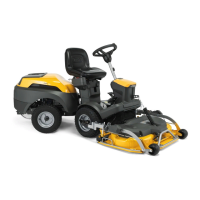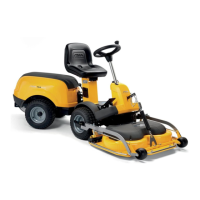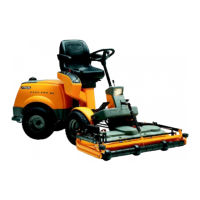WORKSHOP MANUAL
EDITION
PAGE
59 /
124
Example
Belts available on the
market
Original spare belts Notes
Acceleration.
Some belts only en-
gage with the pulleys
when the engine is
running at operating
speed and this gener-
ates excessive heat.
The belt follows the speed
of the engine in continuous
acceleration until the maxi-
mum speed is reached.
Standard belts are made
of natural rubber and only
capable of withstanding
temperatures up to 70°C.
Original spare belts are
made of chloroprene rubber
capable of withstanding
temperatures up to 90°C.
Length.
Manufactured in
standard interval
lengths.
Made in a specific length
designed to ensure perfect
adhesion to the pulley.
The distance between the
pulleys is fixed. The belt
tensioner ensures that the
original belt maintains opti-
mal tension.
Floating pulley on
cutting equipment.
Designed to trans-
mit power between
aligned, parallel and
fixed pulleys.
The original Power Take
Off (PTO) belt is designed
to work even if the pulleys
move up and down and tilt
at the same time.
The equipment follows the
ground beneath it and this
means that the pulley is
constantly moving.
To withstand extreme oper-
ating conditions, the origi-
nal belts are made of fibre
reinforced rubber.
Curvature in two
directions.
Designed to curve
around the pulley in
one direction.
Most of the belts installed
on the machines have
tensioning rollers that act
on the outer side of the belt.
This means that while the
belt is being used it must tilt
both inwards and outwards.
All the original belts, which
work with tensioning arms
acting on the external side,
are equipped with reinforce-
ments.
The reinforcement is de-
signed specifically for these
specific cases.
Noise.
Made without special
requirements for this
specific factor.
The original belts are care-
fully selected to limit the
increase in noise produced
by the machine during
operation.
Depending on the function,
one of the following belt
types is suitable:
• Coated
• Anti-friction
• Open sided
It is essential to maintain the transmission belts in perfect working order for the machine to func-
tion properly.
Premature wear, breakage or deterioration of the V-belts can be caused by:
• Improper tension
• Misalignment
• Damaged pulleys
• Overload
The table shows the possible origins of abnormal situations and the corrective actions to be taken.

